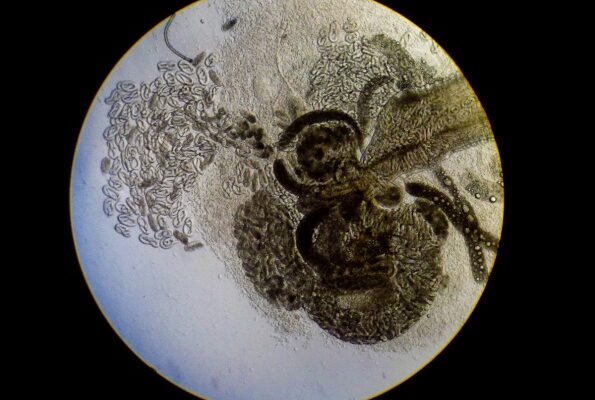Agent
Lungworm is the common name used to describe infestation of the lungs with parasitic worms. Two types of parasitic worm, Crenosoma striatum and Eucoleus aerophilus (formerly Capillaria aerophila), are known to cause lungworm in Western European hedgehogs (Erinaceus europaeus). These parasites can be found on their own, although mixed infections are also common. Crenosoma adults and larvae are found in the trachea, bronchi and alveolar ducts while Eucoleus adults are found in the bronchi and trachea.
Signs of disease
The signs of disease in hedgehogs vary according to the severity of the parasite infestation in the lungs and whether or not there is any secondary bacterial infection present. Signs of lungworm, therefore, can range from no disease to snuffles, wheezes, nasal discharge, increased respiratory effort (sometimes with rattling breathing), cough, weight loss, reduced appetite, weakness, reduced activity, staggering gait and open mouth breathing. In severe cases, the disease can be fatal.
Disease transmission
Transmission of both species of lungworm in hedgehogs is normally via the consumption of infected intermediate hosts which form part of their invertebrate diet. The nematode eggs and larvae are expelled to the environment in hedgehog faeces and then infect the intermediate host (slugs and snails for Crenosoma striatum and earthworms for Eucoleus aerophilus). However, hedgehogs can also pick up infected eggs from a surface contaminated with faeces without the need of an intermediate host. Crenosoma striatum worms can also be transmitted to newborn hedgehogs via the maternal milk.
Distribution
Lungworm has been found in hedgehogs throughout Great Britain and also throughout the species range in Europe and Asia.
Risk to human health
One of the lungworm species that infects hedgehogs (and also infects wild carnivores) in Great Britain, Eucoleus aerophilus, is known to occasionally infect people. This is thought to occur through the ingestion of the parasite worm eggs which may be picked up, for example, from contaminated surfaces.
If you need to handle a hedgehog please use thick gardening or rubber gloves and wash your hands thoroughly with warm water and soap afterwards. Hedgehogs are also known to carry other infectious diseases, such as ringworm and Salmonella, that can affect people.
Risk to domestic animal health
As well as being able to infect hedgehogs and people, Eucoleus aerophilus, can also infect dogs and cats. Infection can occur by eating the intermediate host (earthworms) or by ingesting the parasite worm eggs from the environment.
Dogs and cats are also known to be infected by their own species of lungworm, which they can catch by eating slugs and snails. These species of lungworm, however, are not known to infect the hedgehog.
Figure 1. Crenosoma striatum adult and larvae collected from the lungs of a hedgehog during a post-mortem. Photo credit: Zoological Society of London.
Diagnosis
Diagnosis of lungworm can be achieved by microscopic examination of hedgehog faeces to look for Crenosoma larvae or Eucoleus eggs. Not all hedgehogs infected with lungworm will develop signs of disease. A clinical examination by a veterinary surgeon is necessary to diagnose the disease in a live hedgehog. Similarly, a post mortem examination by a veterinarian is required to diagnose the disease in a dead hedgehog.
If you wish to report finding a dead hedgehog, or signs of disease in hedgehogs, please visit www.gardenwildlifehealth.org. Alternatively, if you have further queries or have no internet access, please call the Garden Wildlife Health vets on 0207 449 6685.
Control and prevention
There is no known control for lungworm in free-living wild hedgehogs.
If you feed hedgehogs in your garden make sure that you rotate feeding sites and clean feeding stations regularly to prevent accumulation of hedgehog faeces.
If you need to handle a hedgehog please use thick gardening or rubber gloves and wash your hands thoroughly with warm water and soap afterwards.
Further information
Bexton, S. (2017) Hedgehogs. In BSAVA Manual of Wildlife Casualties Second Edition. Mullineaux, E., and Keeble, E. Eds.. BSAVA, pp. 117-136.
More information about the diseases affecting hedgehogs can be found on the Garden Wildlife Health website: www.gardenwildlifehealth.org.
More general information about hedgehogs and what you can do to make your garden hedgehog-friendly can be found on the Hedgehog Street website: www.hedgehogstreet.org.
Scientific publications
Traversa D, Di Cesare A, Lia RP, Castagna G, Meloni S, Heine J, Strube K, Mililo P, Otranto D, Meckes O, Schaper R (2011) New insights into morphological and biological features of Capillaria aerophila (Trichocephalida, Trichuridae). Parasitology Research 109:97–104. doi.org/10.1007/s00436-011-2406-4.
Majeed SK, Morris PA and Cooper JE (1989) Occurrence of the lungworms Capillaria and Crenosoma spp. in British hedgehogs (Erinaceus europaeus). Journal of Comparative Pathology 100(1):27–36. doi.org/10.1016/0021-9975(89)90087-X.
Majeed SK and Cooper JE (1984) Lesions associated with a Capillaria infestation in the European hedgehog (Erinaceus europaeus). Journal of Comparative Pathology 94(4):625–628. doi.org/10.1016/0021-9975(84)90069-0.
Acknowledgements
Current funding for the GWH comes in part from Defra, the Welsh Government and the Animal and Plant Agency (APHA) Diseases of Wildlife Scheme (DoWS) http://apha.defra.gov.uk/vet-gateway/surveillance/seg/wildlife.htm; and from the Esmée Fairbairn Foundation, the Universities Federation for Animal Welfare and the Garfield Weston Foundation.
Disclaimer
This fact sheet was produced by Garden Wildlife Health (GWH) for information purposes only. The GWH will not be liable for any loss, damage, cost or expense incurred in or arising by reason of any person relying on information in this fact sheet.
Date of factsheet update:
June 2020

